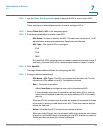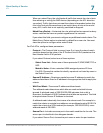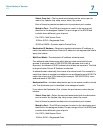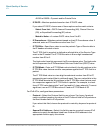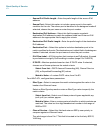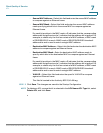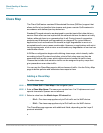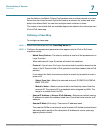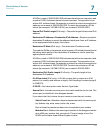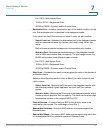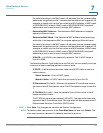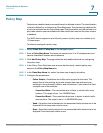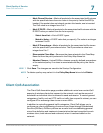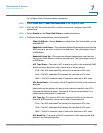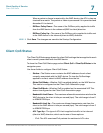
Client Quality of Service
Class Map
Cisco Small Business WAP121 and WAP321 Wireless-N Access Point with PoE 126
7
A DiffServ mask of 255.255.255.255 indicates that all bits are important, and
a mask of 0.0.0.0 indicates that no bits are important. The opposite is true
with an ACL wildcard mask. For example, to match the criteria to a single host
address, use a mask of 255.255.255.255. To match the criteria to a 24-bit
subnet (for example, 192.168.10.0/24), use a mask of 255.255.255.0.
• Source IPv6 Prefix Length (IPv6 only)—The prefix length of the source IPv6
address.
• Destination IP Address or Destination IPv6 Address—Requires a packet's
destination IP address to match the address listed here. Enter an IP address
in the appropriate field to apply this criteria.
• Destination IP Mask (IPv4 only)—The destination IP address mask.
The mask for DiffServ is a network-style bit mask in IP dotted decimal format
indicating which part(s) of the destination IP address to use for matching
against packet content.
A DiffServ mask of 255.255.255.255 indicates that all bits are important, and
a mask of 0.0.0.0 indicates that no bits are important. The opposite is true
with an ACL wildcard mask. For example, to match the criteria to a single host
address, use a mask of 255.255.255.255. To match the criteria to a 24-bit
subnet (for example, 192.168.10.0/24), use a mask of 255.255.255.0.
• Destination IPv6 Prefix Length (IPv6 only)—The prefix length of the
destination IPv6 address.
• IPv6 Flow Label (IPv6 only)—A 20-bit number that is unique to an IPv6
packet. It is used by end stations to signify QoS handling in routers (range 0
to 1048575).
• IP DSCP—See description under Service Type fields.
• Source Port—Includes a source port in the match condition for the rule. The
source port is identified in the datagram header.
If you select the field, choose the port name or enter the port number.
- Select From List—Matches a keyword associated with the source port:
ftp, ftpdata, http, smtp, snmp, telnet, tftp, www.
Each of these keywords translates into its equivalent port number.
- Match to Port—Matches the source port number in the datagram header
to an IANA port number that you specify. The port range is from 0 to
65535 and includes three different types of ports:



